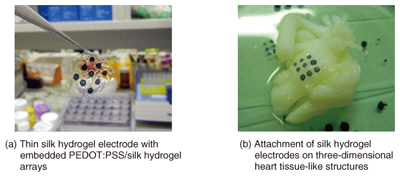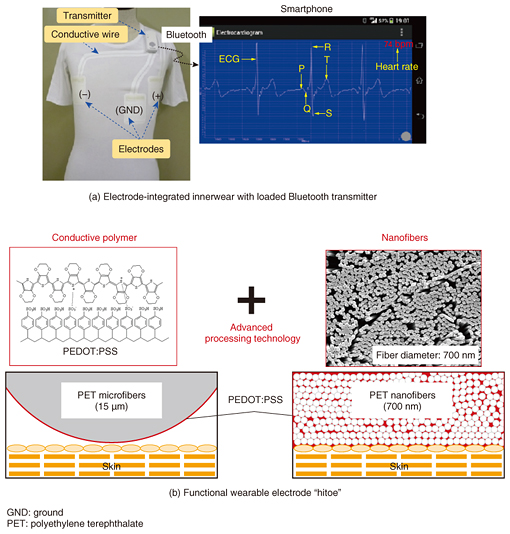 |
|||||||
|
|
|||||||
|
Feature Articles: Forefront Research on Bio-soft Materials Vol. 14, No. 8, pp. 38–43, Aug. 2016. https://doi.org/10.53829/ntr201608fa7 Conductive Composite Material for Vital Data MeasurementAbstractAs the interest in healthcare has grown in recent years, the technologies needed to monitor vital data have been attracting a lot of attention with a view to disease diagnosis and prevention as well as lifestyle improvement. At NTT Basic Research Laboratories, we are working on the research and development of conductive composite materials by coating or mixing conductive polymer with biocompatible substrates. We utilize these materials as electrodes for measuring biological signals from, for example, the skin or the heart, with high biocompatibility and sensitivity. We report here on composite electrodes made of conductive polymer (PEDOT:PSS) and silk substrates that are used when measuring biomedical signals via human tissue. Keywords: biocompatible material, conductive polymer, vital data 1. IntroductionIn recent years, rapid diagnosis and early-stage treatment of disease have become important with the aim of reducing the risk of contracting serious diseases. In particular, there is a strong need to develop methods for continuously monitoring heart rate and for measuring electrocardiographic (ECG) waveforms in order to prevent heart diseases such as heart attack and arrhythmia. Conventionally, metal electrodes and metal-plated fibers have been widely used to measure heart rate and ECG waveforms. However, metal-based electrodes lack flexibility and biocompatibility. As a result, the obtained signals are often affected by high noise, and the patient’s skin may be allergic or sensitive to metal. Furthermore, electrolyte paste is needed to attach medical electrodes to the skin surface, and this may induce a rash and/or itching during long-term use. Our group has focused on the use of PEDOT:PSS (poly(3,4-ethylenedioxythiophene) poly (styrenesulfonate)) as an electrode material that is non-toxic and stable in wet conditions. This molecule, which consists of a π electron-conjugated compound (PEDOT) and a polyelectrolyte (PSS), is widely used as a transparent electrode for touchscreens and displays, and is a replacement for rare metals such as indium tin oxide (ITO). We have been taking advantage of the high hydrophilicity and biocompatibility of PEDOT:PSS to carry out research and development of electrodes designed to measure the action potential of nerve cells [1]. In this article, we introduce biocompatible electrodes that we achieved by integrating PEDOT:PSS with a base substrate such as fibers, without using a metal-based electrode and electrolyte paste. 2. Conductive silk fiberThe high hydrophilic property of PEDOT:PSS molecules means that they swell into a gel in humid environments. Therefore, these molecules exhibit reduced mechanical stiffness, water resistance, and processability, leading to limitations in their use. We avoided these limiting factors by immobilizing PEDOT:PSS on the surface of silk fibers in an electrochemical manner [2]. Images of silk bundles coated with PEDOT:PSS are shown in Fig. 1(a). We can clearly observe the micrometer-scale fine structure of silk fibers that were thinly and uniformly coated with PEDOT:PSS. When we employed PEDOT:PSS/silk electrodes for ECG measurements with experimental animals, electrodes located on the surface of the skin provided us with ECG data that were comparable to data obtained with conventional metal-based electrodes (Fig. 1(b)).
In contrast, it is difficult for the silver-plated nylon electrodes to make good contact with the skin surface. There was also a baseline oscillation in the ECG signals caused by respiratory body motion, which made it difficult to obtain a stable measurement of the ECG waveform. The water-repellent surface of conventional metal-based electrodes caused this difficulty, whereas the PEDOT:PSS/silk composite electrodes with high hydrophilicity meant that the moisture was rapidly absorbed by the fiber, as shown in Fig. 2.
The hydrophilic electrodes tended to absorb sweat and water vapor from the skin, which increased their flexibility and adhesion, making it possible to perform stable measurements. The PEDOT:PSS coating technology is not only applicable to silk fibers but also to a wide range of fibrous materials including polyester and nylon. 3. Conductive silk hydrogel electrodeTo broaden the application range of the PEDOT:PSS/silk composite, we are developing silk substrates with various shapes by solubilizing and molding silk fibers. When this technique was applied to a solution of silk fibroin obtained by chemically treating silk fibers, the solution retained its biocompatibility, hydrophilicity, and processability (Fig. 3(a)). The water solubility of both silk fibroin and PEDOT:PSS enabled them to mix and disperse well, yielding composites with high hydrophilicity. The fibroin protein gelation process with alcohol produced conductive silk-hydrogel electrodes with arbitrary shapes. We employed this process to fabricate a cell-electrode interface for electrical measurements and for the activation of an adherent cell through a photolithographic technique, as shown in Fig. 3(b). A thin-film electrode was formed into the desired shape applicable for cell morphology and function, and it possessed sufficient stiffness to withstand the cell traction force (Fig. 3(c)). By culturing the cells on the surface of films, we were able to collect the cell-laden films and manipulate them into the desired position. When the electrodes were inserted inside the silk hydrogel electrodes, voltage was applied to the entire targeted film. By using this method, we electrically activated the cells to specifically stimulate the voltage-dependent channels expressed on the cells. In the future, we will employ this method to measure the cell action potential of various cells and tissues.
The addition of a photocurable hydrogel to the base material enabled us to produce a large-scale silk-hydrogel based electrode by light irradiation. An image of PEDOT:PSS/silk hydrogel arrays that were patterned on extremely flexible silk hydrogel thin film with high hydrophilicity and biocompatibility is shown in Fig. 4(a). Changing the shape of the mold to fill the precursor during light irradiation made it possible to build an in vivo implantation hydrogel electrode with the desired three-dimensional shape such as a fiber or a suction cup. The fabricated hydrogel electrodes exhibited high breaking strength, flexibility, and stretchability both in air and water in the tensile test because of their high viscoelastic properties. When these electrodes were introduced into the brain tissue of experimental animals, their structure was retained inside the tissue over a long period of time without damaging it. This facilitated the stable recording of brain electrical signals over a period of more than one month. The PEDOT:PSS/silk hydrogel electrodes proposed in this study exhibited little cell toxicity, shape stability, and little change of conductivity even in the body. Thus, we are now working on optimizing the structure of these biocompatible electrodes so that they adhere stably to the surface of pulsating tissue such as the heart (Fig. 4(b)).
4. Development and practical application of “hitoe”By taking advantage of the fibrous form of conductive silk fibers, we developed electrode-integrated innerwear that can record the heart rate and ECG waveforms when the subject wears it. The composite electrodes embedded inside the innerwear are located so that they measure the potential difference between two points on the body surface, thus obtaining biological signals with a high signal-to-noise ratio, as shown in Fig. 5(a). The obtained data were sent via Bluetooth* from a transmitter to a smartphone. The ECG waveform shown in Fig. 5(a) indicates not only a sharp QRS waveform, but also a clearly identified P/T waveform and the heart rate estimated from the number of R wave peaks. The electrodes in the innerwear were attached to the body without the need for electrolyte paste, thus enabling long-term, almost noiseless, and stable measurement of ECG waveforms. To further improve the adhesion to the skin and the moisture-retaining ability of the electrodes, we jointly developed with Toray Industries, Inc. the functional material “hitoe” by employing nanometer-scale fibers. The diameter of a single nanofiber is about 700 nm, and the continuous layers of PEDOT:PSS are highly impregnated within the gaps between nanofibers (Fig. 5(b)). Since the ultra-thin nanofibers increased the contact area and moisturizing effect on the skin, the sensitivity with which bioelectrical signals were detected was greatly improved. In addition, we achieved high functionality by integrating required components. This allowed us to rearrange electrodes, control the wearing pressure, employ electrical wiring suitable for use in clothing, and include a structure to prevent short circuits caused by perspiration and rain.
As hardware for measuring heart rate, biomedical signal measuring innerwear incorporating “hitoe” is being marketed—in collaboration with GOLDWIN INC. and NTT DOCOMO—as a way to monitor the load imposed on the body during exercise. We can expect the combination of heart rate data obtained during exercise with traveling distance and calorie consumption measurements to improve sports performance and to enhance training management efficiency. Moreover, the monitoring of a wearer’s physical condition using “hitoe” will be demonstrated for use as a labor management tool for professionals engaged in dangerous work, long-distance bus/truck drivers, and night workers, or as safety management hardware for the prevention of work-related accidents such as heat stroke and heart attack.
5. SummaryIf we are to measure vital data accurately, the electrode components should be in close contact with the target tissue at all times. The PEDOT:PSS/silk composite electrodes that our group has been working on offer high electrical conductivity, biocompatibility, and flexibility. Therefore, the electrodes are capable of measuring biological signals with long-term stability even when attached to the skin and in vivo tissue. By integrating them with innerwear, we have developed wearable bioelectrodes for measuring heart rate and ECG waveforms with high precision without burdening the wearer. Simply by wearing these bioelectrodes, we can easily undertake our own health management for longer periods regardless of whether we are engaged in normal activity or are exercising or sleeping. Furthermore, by solubilizing silk fibers, we produced PEDOT:PSS/silk composite electrodes with the desired shapes. For example, we fabricated micrometer-sized thin electrode films in order to apply voltage to cells, and millimeter-sized implantable electrodes to record electrical signals from tissue. Since these electrodes are derived from aqueous silk fibroin solution, they can be blended with any types of additives such as ethylene glycol to increase the conductivity or cell differentiation/growth factors corresponding to the types of cells and tissues. Currently, we are further developing these technologies to realize a complex and three-dimensional multi-electrode array. We expect them to be applicable as in vivo implantation electrodes that are attached to the surface of tissues and that measure signals from multiple points within them, in order to obtain basic knowledge of the profound information contained inside the human body. References
|
|||||||
















